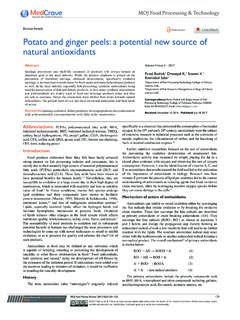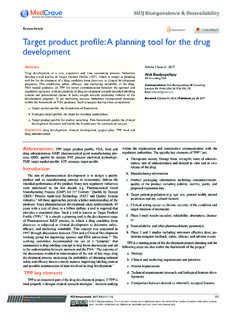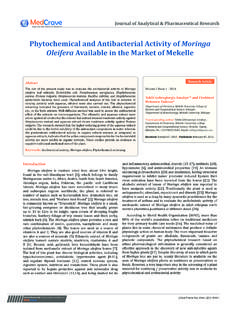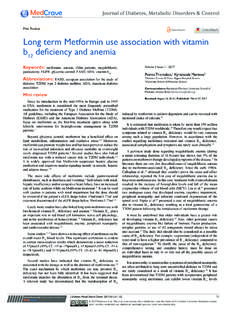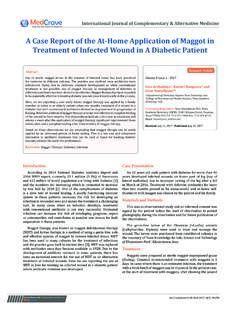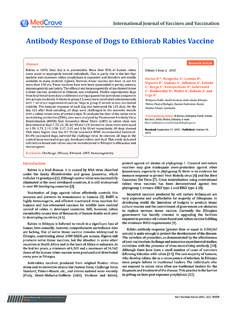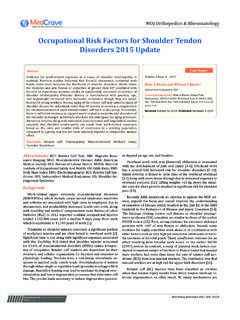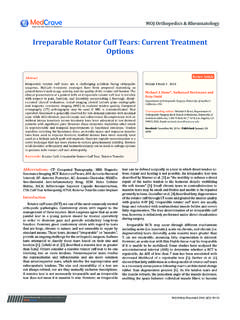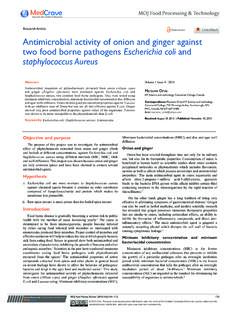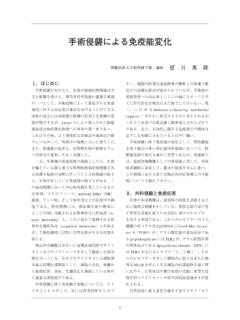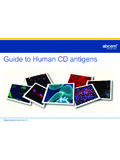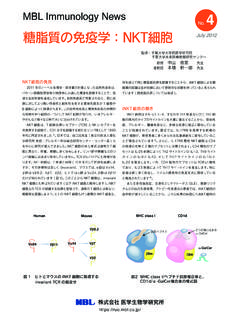Transcription of Dendritic Cell Vaccine and its Application in Cancer …
1 International Journal of Vaccines & VaccinationDendritic Cell Vaccine and its Application in Cancer therapy Volume 1 Issue 1 - 2015 Farashi-Bonab S1 and Khansari N2*1 Department of Immunology, Tehran University of medical Sciences, Iran2 American Medical Diagnostic Laboratory, USA*Corresponding author: Nemat Khansari, American Medical Diagnostic Laboratory, 1665 Garden Grove Blvd, Garden Grove CA 92843, USA, Tel: +1(949) 228-8290, Email: Received: April 7, 2015 | Published: May 18, 2015 AbstractDendritic cells (DCs) are the most potent antigens presenting cells in the immune system. They have a high capacity to trigger antigen-specific immune responses and promote both adaptive immunity and innate immunity. In the past decade, DC Vaccine has been introduced as a new therapeutic strategy in Cancer patients.
2 DC-based immunotherapy is safe and can promote antitumor immune responses and prolonged survival of Cancer patients. However, the current approaches of DC vaccination are far from optimal efficacy in advanced cancers. In this paper, we present recent findings about DC Vaccine , its clinical Application and efficacy in various cancers, as well as improved approaches in the preparation of DC : Dendritic cells ; Function; Ex vivo generation; Vaccine ; Cancer treatment; EfficacySubmit Manuscript | J Vaccines Vaccin 2015, 1(1): 00002 Abbreviations: DC: Dendritic Cell; APC: Antigen Presenting Cell; PRR: Pathogen Recognition Receptor; TLR: Toll Like Receptor; CLR: C-Type Lectin Receptor; MHC: Major Histocompatibility Complex; cDC: Conventional DC; pDC: Plasmacytoid DC; iDCs: Inflammatory DC; ICAM-1: Intracellular Adhesion Molecule-1.
3 LFA-3: Lymphocyte-Function Associated Antigen-3; IL: Interleukin; NK: Natural Killer; NKT: Natural Killer T; PD-L: Programmed Death-Ligand; TRAIL: TNF-Related Apoptosis-Induced Ligand; TGF- : Transforming Growth Factor- ; IDO: Indoleamine 2,3-Dioxygenase; NO: Nitric Oxide; Treg: Regulatory T Cell; Breg: Regulatory B Cell; GM-CSF: Granulocyte-Macrophage Colony Stimulating Factor; TAA: Tumor Associated Antigen; TSA: Tumor Specific Antigen; Flt3: Fms Like Tyrosine Kinase 3; LPS: Lipopolysaccharide; BCG: Bacillus Calmette-Guerrin; IFN: Interferon; TNF- : Tumor Necrosis Factor- ; FDA: United States Food and Drug Administration; CMV: Cytomegalovirus; PAP: Prostatic Acid Phosphatase; MART-1: Melanoma Antigen Recognized By T Cell-1; NY-Eso-1: New York Esophageal Squamous Cell Carcinoma-1 IntroductionCancer cells recruit several mechanisms to escape from immune systems [1].
4 Innovation of approaches to increase antitumor reactivity of effector immune cells is essential for optimal antitumor immunity. DCs, as the most potent APCs, have a major Application in Cancer immunotherapy by presentation of tumor specific/associated antigens, activating antitumor lymphocytes, and augmenting innate immunity. More than two decades before, DCs were generated in the culture medium from bone precursor cells [2]. Afterwards, DC-based vaccines were studied in order to use as a therapeutic or prophylactic tool in malignant disorders. At present, DC vaccines are offered as a valuable instrument in Cancer treatment. In this paper, we discuss anticancer DC vaccines, their Application , safety, and clinical efficacy, as well as recent advances in DC Vaccine preparation.
5 Immunophenotype and function of DCsDCs are a heterogeneous population of cells with a widespread tissue distribution. They have a distinctive morphology with many veil-like projections and express PRRs, such as TLRs and CLRs, the endocytic receptor DEC-205, and FC receptors. DCs also express 10-100 fold higher levels of peptide-MHC complexes than other professional APCs, monocytes and B cells , on the cell surface. Indeed, DCs have a high ability in receptor-mediated endocytosis and macropinocytosis, antigen processing and presentation on the MHC class I and II molecules [3,4]. They promote induction of antigen-specific immune responses and also augment innate immunity [5,6].
6 DCs are also important in induction of Immunological tolerance [7]DC subsetsMyeloid DCs and plasmacytoid DCs: DCs can be categorized into two major subsets based on their origin: myeloid or conventional DCs (cDCs) and plasmacytoid DCs (pDCs). cDCs are derived from myeloid progenitor cells in the bone marrow and are characterized by expression of CD11c. cDCs can be subdivided into monocyte-derived DCs, CD1a- interstitial DCs, and CD1a+ Langerhans cells . pDCs differentiate from lymphoid progenitor cells in the lymphoid tissues and characterized by expression of CD123 and production of a high levels of type I interferon. During inflammatory response, inflammatory DCs (iDCs) are originated from monocytes [8].
7 Immature DCs and Mature DCs: DCs are classified into immature and mature subsets based on their immunophenotype and function. Immature DCs have high capacity to capture antigens and are usually found in the peripheral non-lymphoid tissues. After antigen capture, they migrate into lymphoid tissues and become matured by up-regulation of expression of MHC molecules I and II, co-stimulatory molecules such as CD40, CD80, and CD86, and adherent molecules such as ICAM-1(CD54) and LFA-3(CD58) on the cell surface as well as secrete various soluble factors including various chemokines and cytokines such as IL-12. Consequently, mature DCs can present antigens in the lymphoid tissues and prime, activate, and expand effector immune cells [5,6,9].
8 Mini ReviewDendritic Cell Vaccine and its Application in Cancer Therapy2/5 Copyright: 2015 Bonab et : Farashi-Bonab S, Khansari N (2015) Dendritic Cell Vaccine and its Application in Cancer therapy . Int J Vaccines Vaccin 1(1): 00002. DOI: DCs and tolerogenic DCs: DCs have strong immune-stimulatory properties. They can activate CD4+ and CD8+ T cells , B cells , NK cells , NKT cells , T cells , and other immune cells . But, DCs have also important roles in the induction of immunological tolerance through various mechanisms including expression of the immunosuppressive molecules such as PD-L1 and -L2, CD95 (Fas), TRAIL, and galectin-1, and secretion of immunosuppressive mediators such as IL-10, TGF- , IDO, IL-27, arginase-1, heme oxigenase-1, and NO.
9 Both pDC and cDCs can be tolerogenic. These tolerogenic DCs suppress immune responses of different effector cells ; for example, they induce T cell anergy or apoptosis and promote the development and expansion of Tregs and Bregs [1,10]. Ex vivo generation of DCsDifferentiation of DCs from DC-precursor cells : DCs exist in a low frequency in the peripheral blood, at about of white cells . Isolation of DCs from blood or other tissues is difficult due the low frequency of these cells . Currently, DCs are generated from precursor cells at large numbers ex vivo [11-13]. We and others generated DCs ex vivo with a high purity [14]. Various agents such as GM-CSF, Flt3 ligand, c-Kit, IL-3, and IL-4 have been used to differentiate and growth DCs ex vivo.
10 Human DCs are usually generated ex vivo from peripheral blood CD14+ monocytes in the presence of GM-CSF or GM-CSF/IL-4. Also, CD34+ hematopoietic stem cells can be used for ex vivo generation of DCs. Mouse DCs are usually generated from bone marrow precursor cells . Antigen loading of DCs: Antigen loading of DCs is an important process in ex vivo generation of DCs for clinical applications . TSAs/TAAs are suitable targets for loading on DCs. Synthetic peptides have been used for antigen loading of DCs [15-17]. However, synthetic peptides are only accessible for cancers with defined TSAs/TAAs. Tumor lysate is other approach for antigen loading of DCs. This approach has been used successfully in many studies [18-21].
